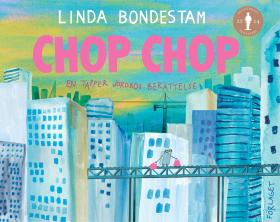
Chop Chop: En tapper jordbos berättelse
(Chop Chop: The Story of a Brave Earthling)
by Linda Bondestam
reviewed by Elizabeth Lutz
Linda Bondestam’s prize-winning picture book is filled with humour and unexpected turns right to its very end. Chop Chop is a cheerful robot who starts work at a shipping plant. The manager is bursting with praise for this small and mighty robot who is not only stronger and more efficient than all the other workers put together, but also doesn’t need to eat, take breaks, or be paid a wage. The other employees are dismissed and Chop Chop misses the company of his co-workers. Then a newer, more efficient robot comes along and both the manager and Chop Chop are forced to find new employment.
Chop Chop is reprogrammed for a series of other jobs including delivery, dog walking, day care, and writing books—none of which work out. He is then drafted to find mines in a war zone, something no human will do. During the war, the biggest bomb wipes out all life on earth for at least a hundred years, yet, gradually, the plants regrow and all the solar powered robots wake up and populate a world of their own. ‘But something’s missing?’, Chop Chop thinks. Of course, it’s people. This good-natured little robot loved the company of humans, and: ‘the little ones were especially fun!’ He founds an IVF Clinic (according to the words above the door) and starts a new generation of ‘happy earthlings’.
The book supports a nuanced discussion about AI: it’s neither all good nor all bad. Readers meet Chop Chop even before the title page in a prologue that shows his creation: ‘The beginning of everything was a circuit board, a small solar motor, a processor, a speaker, a stainless-steel box, a motherboard, two optic lenses and every other little piece imaginable which mostly looked like scrap.’ A pair of human hands is the focal point of the illustration. The prologue calls attention to the fact that Chop Chop was created by a human for a purpose; he didn’t spring spontaneously into being. It also foreshadows the end of the book in which Chop Chop creates new people from frozen cells: ‘The beginning of everything is the meeting of some cells, muscle mass and bone tissue. And soon, very soon, many tiny hearts are beating. The test tubes bubble with life.’ Chop Chop as a character is illustrated with human-like emotion in his unusually large eyes. He’s not as similar in shape to humans as some of the other robots in the book, but he does have arms, eyes, a mouth, a body, and wheels that function as legs. Through the use of the word jordbo in the Swedish title, which literally means an inhabitant of the earth, his robot nature is de-emphasised. This is the story of a brave being who lives on earth—robot or not. The use of the words omprogrammerad (reprogrammed) and omprogrammering (reprogramming) is also not exclusive to robots, but applied to humans at the end of the book. In an interview with Hufvudstadsbladet, Linda Bondestam said that winning the August Prize for Chop Chop: ‘shows that you can make children’s books about any subject whatsoever and also difficult contemporary themes.’
Part of the book’s appeal is its humour. Bondestam includes jokes for the adult audience such as a reference to the song ‘Öppna landskap’ (Open Landscapes) by Ulf Lundell. The irony of one robot being replaced by another robot is also not lost on mature readers. She even includes herself in the book when a smiling Chop Chop enters her studio to write and illustrate picture books. (Protesting artists promptly boot him out of the industry.) Chop Chop is actually quite adept at his day care job, so much so that the parents get angry. When the kids come home they expect their parents to be as perfect as robots!
Children may especially connect with Chop Chop’s size in the illustrations. Unlike the other robots, he is small, not the height of the adult characters in the book, but just the size of the children. This is particularly noticeable in the spread where Chop Chop works at day care, ‘a place teeming with miniature bosses.’ It is, after all, the children who Chop Chop thought were especially fun. In the book’s final spread, child readers may notice that Chop Chop is actually reading this very book to his audience.
While other modern picture books would have ended after Chop Chop and the manager are fired from the shipping plant, or perhaps would have found a new situation for Chop Chop much sooner, the courageous spirit at the heart of this book more than makes up for its lengthy plot.

Chop Chop: En tapper jordbos berättelse
Förlaget, Finland, 2024, 44 pages
Rights: Rights & Brands
Linda Bondestam is a Finland-Swedish author and illustrator living in Helsinki. She is the illustrator of more than 30 books including Djur som ingen sett utom vi (Animals Nobody Has Seen Except Us) by Ulf Stark (reviewed in SBR 2017:1) and Yokos nattbok (Yoko’s Night Diary) by Annika Sandelin. As author and illustrator her books include Mitt bottenliv—av en ensam axolotl (My Life at the Bottom: The Story of a Lonesome Axolotl), God morgon rymden (Good Morning, Space), and, most recently, Chop Chop: En tapper jordbos berättelse, which was awarded the August Prize for best Swedish children’s book in 2024. She is a member of the Swedish Academy for Children’s Books.
